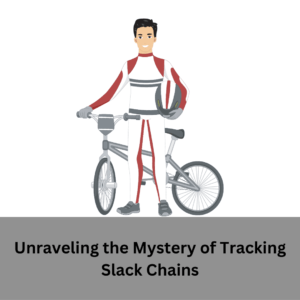Have you ever been cruising down the road on your bike, the wind in your hair and the world at your feet, only to have your chain suddenly start misbehaving? It’s like it decided to take a little detour of its own, leaving you with a not-so-smooth ride. This phenomenon is what we call a “slack chain”. If you’ve ever experienced this, you’re not alone. Let’s delve into the world of tracking slack chains, and I’ll share some personal experiences and anecdotes along the way.

What is a Slack Chain, Anyway?
Before we jump into the nitty-gritty, let’s get one thing straight. A slack chain is when your bicycle or motorcycle chain becomes loose and saggy. It’s as if your chain suddenly decided to take a break and hang out where it’s not supposed to. Picture this: you’re pedaling along, and instead of a smooth ride, you hear that annoying slapping noise, and your bike seems to lose power. That’s the slack chain causing havoc.
Personal Encounter with a Slack Chain
I’ll never forget the day I was cruising down a scenic trail on my trusty bicycle. The sun was shining, the birds were chirping, and everything was just perfect. That is, until my chain decided to play rebel. Suddenly, there it was – that unmistakable slapping sound. It was as if my bike was protesting against the very idea of a peaceful ride. I had to pull over, wrestle with the chain, and get it back in line.
The Mechanics of a Slack Chain
Now, you might be wondering, why does this happen? Well, it all comes down to the mechanical workings of your bike. When a chain becomes slack, it disrupts the smooth transfer of power from your pedals to your wheels. It’s like trying to run with a loose shoelace – you’re just not going to get very far.
DIY: Identifying a Slack Chain
Spotting a slack chain isn’t rocket science. There are some telltale signs that can help you identify this pesky problem. Take a close look at your chain. Is it hanging down more than usual? Does it sag excessively when you push it upwards? If the answer is yes, you’ve got yourself a slack chain.
Causes of Slack Chains
So, what leads to this chain rebellion? There are a few common culprits. Wear and tear is a big one. Over time, your chain can stretch and lose its original tension. Improper tensioning during installation or maintenance can also play a role. And let’s not forget the importance of lubrication – a dry chain is more likely to go slack.
A Quick Fix: Tightening the Chain
The good news is that you don’t need a degree in engineering to tackle a slack chain. Tightening it up is a fairly straightforward process. Grab your trusty tools and follow these steps:
1. Locate the Tensioner: Your bike should have a mechanism for adjusting chain tension. Find it – it’s usually near the rear wheel.
2. Loosen the Bolts: Gently loosen the bolts holding the tensioner in place.
3. Adjust the Tension: Move the tensioner to tighten the chain. You want it to have a bit of give, but not so much that it’s sagging.
4. Double-Check: Once you’ve made your adjustments, give the chain a spin. It should move smoothly without any excessive sagging.
Remember, it’s all about finding that sweet spot of just-right tension.
Regular Maintenance: Preventing Slack Chains
Like any part of your bike, your chain needs a little TLC from time to time. Regular maintenance is the key to keeping it in optimal condition. Here are some tips to keep in mind:
– Clean and Lubricate: Give your chain a good clean and apply some quality lubricant. This helps reduce friction and wear.
– Check for Wear: Keep an eye on your chain’s condition. If you notice any significant stretching or wear, it might be time for a replacement.
– Monitor Tension: Every now and then, check the tension of your chain. A little adjustment can go a long way in preventing a slack chain.
Riding with a Slack Chain: Risks and Precautions
Now, you might be wondering, is it safe to ride with a slack chain? Well, let’s just say it’s not ideal. A slack chain can lead to reduced power transfer, making your ride less efficient. Plus, there’s the risk of the chain slipping off entirely, which can be a major safety hazard.
Seeking Professional Help
While it’s empowering to DIY your bike repairs, there are times when it’s best to call in the pros. If your chain is consistently going slack despite your best efforts, or if you suspect there might be other underlying issues, it’s time to pay a visit to your local bike shop.
Personal Reflection: Learning from Chain Mishaps
Dealing with a slack chain can be frustrating, but it’s also a learning experience. It’s taught me the importance of regular maintenance and keeping a watchful eye on my bike. After all, a little bit of care goes a long way in ensuring a smooth, hassle-free ride.
Common Myths and Misconceptions
Before we wrap up, let’s bust a few myths about slack chains:
– Myth 1: A little slack is fine. While a bit of give is okay, an excessively slack chain can lead to problems down the road.
– Myth 2: Lubrication doesn’t matter. Wrong! Proper lubrication is crucial in preventing a slack chain.
– Myth 3: Tightening the chain is complicated. It might sound intimidating, but with a little know-how, it’s a straightforward process.

Conclusion
So there you have it – the lowdown on tracking slack chains. Remember, a well-maintained chain is the key to a smooth, enjoyable ride. Take the time to give your bike the care it deserves, and you’ll be rewarded with many more miles of trouble-free cycling. Happy riding!
FAQs: Demystifying Slack Chains
1. How often should I check my chain for slack?
– It’s a good idea to give your chain a once-over after every few rides, and perform a thorough check every month or so.
2. Can I use any type of lubricant on my chain?
– While there are many lubricants out there, it’s best to use one specifically designed for bike chains.
3. Is it safe to ride with a slightly slack chain?
– A small amount of slack is usually okay, but if it’s excessive, it’s best to address it to prevent further issues.
4. What tools do I need to tighten a slack chain?
– You’ll need a wrench, Allen keys, and possibly a chain tensioner tool, depending on your bike’s setup.
5. How long does a bike chain typically last before it needs replacement?
– With regular maintenance, a bike chain can last anywhere from 1,000 to 3,000 miles, but this can vary based on factors like riding conditions and maintenance practices
- Park Tool: Chain Maintenance – This link provides detailed guidance on chain installation and maintenance, which complements the DIY section of the article.
- Bicycle Chain Wear: How to Tell When It’s Time for a Change – This link offers valuable information on recognizing signs of chain wear and when it might be time for a replacement, which aligns with the section on regular maintenance.
Watch this one,
Video Credits – Global Cycling Network
DOWNLOAD THIS ARTICLE :Click Here
You May Also Like
-
Unraveling the Mysteries of the Jamis Diablo: A Casual Cyclist’s Guide
-
Unraveling the Trek 6061T6: A Comprehensive Guide to Your Dream Bike




